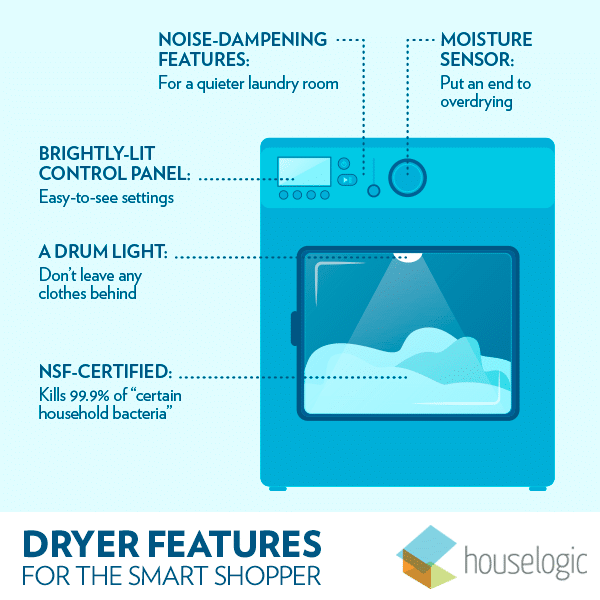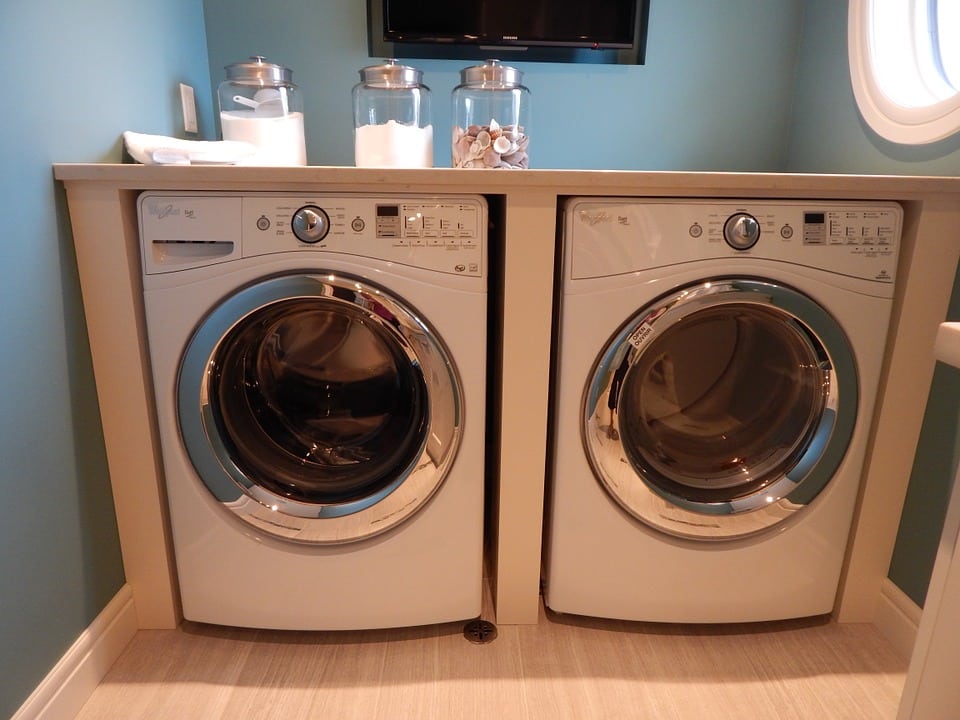By Deirdre Sullivan is an NYC-based writer who’s obsessed with maximizing every inch of her urban dwelling. She’s a former fashionista who has worked for Lucky Magazine and InStyle. She recently traded her high heels and Fashion Week pass for a drill and bandsaw. Follow Deirdre on Pinterest.
New features and whiz-bang options complicate buying a new clothes dryer. Here’s what you need to know to make a smart, budget-minded decision:
Thanks to game-changing technologies and spanking new energy standards, the latest clothes dryers are loaded with settings that boost performance and features that add functionality.
Although all of this good stuff can lower energy use and expand the lifespan of the fabrics we dry, it can make selecting the right machine a daunting process.
We’ll point out what you need — and what you don’t — so you can pick the best clothes dryer for your home and budget.

First Things First: Gas or Electric?
Decision numero uno is whether to buy a gas or electric dryer. If you don’t have a natural gas supply to your house, the choice is simple — you go electric. But if you do, we give the edge to energy-saving gas. Here’s why:
- Gas dryers get the job done in less time because they heat up faster than electric dryers.
- Depending upon your local utility rates, natural gas can be cheaper than electricity.
FYI: The Natural Resources Defense Council crunched the numbers and says, on average, an electric clothes dryer can cost $100 per year to run while a gas dryer can cost about $40.
How Much Does a New Machine Cost?
Other than operating cost, there’s little price difference between gas and electric machines. You’ll find dryers from $250 to $1,550, with prices for gas dryers slightly higher than electric machines with comparable features.
The Clothes Dryer Gets an Energy Makeover
Over the last 20 years, many household appliances like clothes washers and refrigerators have become significantly more energy efficient. However, standard clothes dryers have been stuck in the early 1990s, when minimum energy standards for these machines first went into effect. The typical dryer sucks up as much power annually as a new washing machine, dishwasher, and refrigerator combined.
Starting in 2014, there’s been a tiny improvement in energy efficiency. The Department of Energy requires the newest machines (gas and electric) to be 5% more efficient than the previous generations.
That’s only about $2 to $5 a year in savings, assuming that, on average, an electric dryer costs about $100 a year to run and a gas dryer costs about $40 to operate, according to the National Resources Defense Council.
If energy savings is really important to you, the latest wave Energy Star-certified dryers use 20% less energy than today’s standard models. Prices start at about $800.
Tip: If you’re shopping for an Energy Star-certified dryer, check out its combined energy factor (CEF), a standard established by the Department of Energy. The higher a machine’s CEF, the more energy-efficient it is. You can find and compare the CEF for Energy Star dryers here.
New Kid on the Block: The Heat-Pump Dryer
We won’t see real energy savings on dryer technologies unless the heat-pump becomes popular.
This type of dryer is so new in the U.S. that there’s currently only one model available. However in Europe, there are at least 25 models, and they’re the only type of dryer that qualifies for Europe’s top energy-efficiency rating. Here’s more:
- These ventless machines use up to 60% less energy than standard electric dryers because they recycle heat instead of venting it.
- They’re so green-tastic that they’re the only type of dryer that can be legally sold in the most eco-friendly country in the world, Switzerland.
- The first model available for retail sale in the U.S., LG’s EcoHybrid dryer, is Energy Star-certified and retails for around $1,600.
Tip: The good news is other brands like Whirlpool are releasing additional models. This may help lower retail costs.
Want to Color Your World?
It’s no secret that clothes dryers are available in eye-catching shades like electric blue, ruby red, and metallic carbon. But you may not know that they can cost $100 to $200 more than their plain white counterparts, whether they’re sold individually or with a matching clothes washer.
Size Does Matter
Especially if you want enough clearance to open your dryer’s door, and if you want the machine to handle your household’s average-sized load. Here are a few pointers:
- The standard width of clothes dryer is 27 to 29 inches. Small space? Consider a trimmer dryer or a stackable washer-dryer set.
- For optimum drying, you’ll want a machine that’s twice the capacity of your clothes washer. This will allow heated air to circulate through and around your wet laundry efficiently. Just so you know: Drum capacity is measured in cubic feet, with most models ranging from 5.5 to 7. The drum capacity for most standard washing machines ranges from 3.6 to 4.2.
- If you wash bulky, oversized items on a regular basis, consider a larger-than-average capacity dryer.
Tip: Dryers (and washers) need a little breathing space. Make sure there’s at least an inch or two of space around both so air can circulate around them.
Features and Functions You Should Have
Moisture sensor: This feature puts an end to overdrying, which can damage your clothes. Machines with moisture sensors automatically shut off when a load is dry. A dryer that runs 15 more minutes than it needs to on each load can cost you $34 per year. Here’s more:
- It’s a staple on all Energy Star dryers.
- It’s a feature on many new conventional machines that cost more than $600.
- Machines that cost less than $600 may have a feature called “auto dry” that’s supposed to do the same thing. But “Consumer Reports” says the feature is fickle; it often fails to turn the dryer off.
Noise dampening: Hate the racket a dryer can create? A feature like this can spare your sanity if your machine is close to your main living area. The dryers that scored best for noise reduction start at $900, according to “Consumer Reports.”
A brightly lit control panel: Will your new machine be located in a poorly lit corner or basement? This illuminating feature will spare you from squinting.
A drum light: This can help put an end to stray socks and other pieces of small, lost laundry.
An NSF-certified dryer: Although some dryers claim to kill germs and bacteria, only NSF-certified models can zap 99.9% of “certain household bacteria.” NSF sets standards for, tests, and certifies products in the interests of public health. Here’s more:
- Washing your laundry, especially underwear and sheets, in low temperatures creates a breeding ground for germs and bacteria. An NSF-certified dryer will help get your laundry hygienically clean.
- NSF-certified dryers start at $899, and may use more energy than non-certified dryers when running the sanitizing cycle.
Features and Functions You Shouldn’t Pay More For
Removable dryer rack: Dryer racks protect hats, sneakers, and delicate items from getting knocked around by suspending them above the drum for tumble-free drying. The feature is typically unavailable on modestly priced machines (dryers under $500). But, most people don’t use it that much.
Stainless steel drums: Unlike ceramic-coated steel drums, stainless steel ones stay free of nicks and scratches caused by metal zippers, buttons, and rivets. However, they don’t enhance dryer efficiency.
Wi-Fi enabled: Being able to control your machine remotely through an app on your computer or personal device can burn you. The National Fire Protection Association says a clothes dryer should never be operated when you’re sleeping or out of the house. One out of every 22 home structure fires between 2006 and 2010 involved a dryer or washing machine.
Touch pads: This smart feature may save your dryer preferences, but it doesn’t enhance machine performance or functionality.
Variable settings for time and temperature: Don’t pay more for a dryer just because it has drying options with buzzy names like eco-dry or active wear. Many, if not all such options, can be easily replicated using a basic setting and the dryer’s timer. Here are two examples:
- Eco-mode: It may sound environmentally friendly, but it’s nothing more than a low heat setting with an extended drying time.
- Speed dry: You can achieve the same effect by running a load for 15 minutes on high heat.
Additional settings that can increase energy use:
Wrinkle guard: Once clothing is dry, it’ll tumble laundry without heat for up to an hour. But it increases a cycle’s energy use by up to 10%.
Steam modes: They promise to remove wrinkles and freshen up clothing. But here’s what gets us hot under the collar: This function can use 20% of the energy spent on a regular drying cycle without removing a single crease. Cost-conscious consumers claim to achieve similar results by adding a damp washcloth to a wrinkled load.
Installing a Gas Dryer
- Hire a licensed plumber to install a gas line to your laundry room. Extending a gas line costs $150 to $1,000, depending on the length and complexity.
- Hire an HVAC contractor who specializes in dryer vent installation. Cost depends on how close your laundry room is to an exterior wall and how labor intensive it is to cut through. Homeowners can expect to pay $150 to $500.
FYI: You’ll also have to plug your gas dryer into a 120-volt outlet.
Installing an Electric Dryer
- Add a dedicated 220-volt circuit. If your laundry room doesn’t have one, you’ll need a licensed electrician to install. Costs range from $300 to $800.
FYI: About 72% of residential clothes dryers are electric.
Getting Rid of an Old Dryer
- You may be able to trade it for a rebate on your new machine. Check with your retailer before buying.
- If it’s in good working condition, donate it to a local charity. Doing good may score you a tax deduction.
- If it’s kaput, check with your local municipality on how to recycle.
Visit HouseLogic.com for more articles like this. Reprinted from HouseLogic.com with permission of the NATIONAL ASSOCIATION OF REALTORS®.











